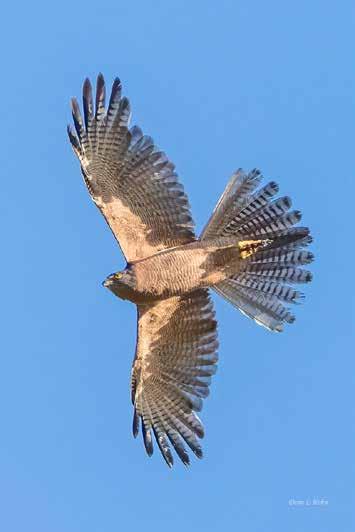
4 minute read
ARTICLE
DOWN UNDERartists
Australia and New Zealand
PHOTOGRAPHY TIPS
INTRO TO BIRDS IN FLIGHT PHOTOGRAPHY
By Dean Hohn
For me, bird photography is one of the most challenging genres of photography I’ve ever tried. It can be extremely rewarding when it all comes together but it can also be one of the most frustrating when it doesn’t!
I hate to think of the number of shots I’ve deleted that were just rubbish! Slowly over the past 18 months, I have concentrated on bird photography. I had taken the odd photos of birds if one presented itself, but I wasn’t dedicated to photographing them such as I have been since July 2019.
It has been an interesting and steep learning curve. I’d like to share some of the things I feel are important to learn that will enable you to go from photographing perched birds to photographing birds in flight. I’m still learning, reading, and practicing while trying to understand more and more about the various birds in my area.
One of the first things you need to do is learn the habits of birds and the habitats they frequent. The more you understand the habits of the birds, the easier it becomes to find, track and photograph them.
I suggest you start off with larger slow flying birds and learn how to consistently track them with your camera, even if you don’t actually take a photo of them initially. The more practice you put in the better you will become at being able to track and anticipate what the bird will do in flight. Then all you have to do is track the bird and wait for the right moment to get the capture you want.
I’m fortunate that I live near the sea and I’m only a block away from the river where there is no shortage of seagulls and other water birds to practice on. I am also fortunate to have multiple species of small birds that are prevalent where I live. They are quick, a challenge, and good to practice on once you are accustomed to tracking the slower birds. Some of the smaller birds are so fast you will need a camera that has an excellent autofocus tracking capability to enable you to have any chance of consistently being able to get shots of them.


Dean Hohn - Brown Goshawk When getting ready to press the shutter button, think of the impact the composition of your photograph is going to have. Is the bird flying overhead and looking at you, is it flying towards you, or is it flying across you? These are the main considerations I’ve found that impact the feel and strength your photos.
When it comes to equipment, buy the best your budget can afford. You’ll need to make a decision whether you buy a full-frame camera or a cropped sensor camera or variants thereof. I’ve always had full-frame cameras, but a cropped sensor camera provides extra reach over the full frame. Nikon 1.5x and Canon 1.6x and Micro 2/3s are 2.0x. To give you an example: A 600mm lens on a full frame Nikon camera allows you to take images at 600mm. That same lens on a cropped sensor Nikon camera gives you 900mm focal length (600mm x 1.5=900mm).
The full frame camera allows you to crop your images without losing detail more so than a cropped sensor camera. It also allows you to process your images to a greater extent without degradation.
The quality of glass (lens) is one of the most important factors to consider when buying a lens for birding. The quality of the lens is more important than the choice of camera. A poor-quality lens will never take a sharp photo, no matter how good the camera is, but a good quality lens will always be capable of taking a sharp photo no matter the body it’s on!
Weight is another factor to consider. The older I get, the less weight I’m capable of carrying and handholding to shoot. I find a tripod just isn’t user friendly unless you’re set up in a blind or in a location where a perch is set up and you are waiting for the birds to come to you. I have recently started using a monopod fitted with a Wimberley Mono-gimbal head and I’m finding it assists me tremendously to be able to steadily track a bird while panning. It is also a game changer when you have a perched bird and you’re waiting for it to launch. Before I started using the monopod, invariably I would have to lower my arms to rest them and the bird would then launch, and I missed the shot. Now I let the monopod support the camera and lens while I can wait for the right moment to take the shot and my success rate has dramatically improved.






